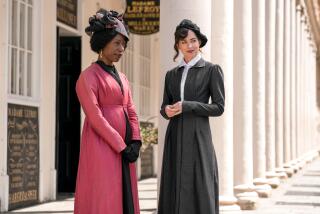Of Her Times, Yet for All Time
- Share via
One salient fact often forgotten by those who champion a return to the moral and intellectual certainties of good old-fashioned religion is that a considerable percentage of the people who abandoned their faith in the 19th century started off as devout, often fervent believers. Some, it’s true, were temperamental scoffers, sophisticated Voltairean skeptics or dashing Byronic reprobates. But many had more in common with that quintessential Victorian George Eliot, whose life and work express a good deal of the complexities and perplexities of life in 19th century Britain.
The eminent Victorian novelist was born Mary Anne Evans in 1819. Mary Anne was a lonely child from a distinctly nonbookish background. Sent away to school, the little girl was plunged into the world of evangelical religion and resolved to become a paragon of goodness. As a teenager, she read voraciously--although she scorned novels in favor of theology, philosophy and natural science. The more she meditated on serious issues of conscience, ethics and belief, the more she came to doubt the literal truth of the Bible, and on the fateful day of Jan. 2, 1842, she outraged her father by refusing to attend church.
As Kathryn Hughes, her latest biographer, points out, Mary Anne’s refusal was doubly distressing to her father because going to church was one way in which a young woman might meet eligible men. Her father, like many a Victorian parent, was desperate to get his daughter off his hands, a task made harder by the fact that she was exceedingly plain to look at.
Never afraid to defy convention to follow her conscience, the woman who later became known under the pen name George Eliot chose to compromise with her father: She would attend church but only on condition that she was free to think what she pleased during the service. As Hughes puts it, “She would not give up her new beliefs for the sake of respectability, but she would forgo the glamour of shouting them from the roof-tops.” Later, after a series of awkward entanglements with men, she fell in love with the journalist George Henry Lewes, who was married to a woman he could not divorce. Owing to the draconian divorce laws of the time, he could not even divorce his wife for her ongoing affair with another man, because he had earlier, in accordance with his free-love principles, condoned her adultery by accepting her child by her lover.
When Mary Anne nonetheless decided to live with Lewes as man and wife, even her progressive-minded friends were shocked. It was years before she was accepted by “respectable” society. But the novels she would write won her a wide and almost worshipful following. Ranging from the luminously Wordsworthian “Adam Bede” to the ambitiously cosmopolitan “Daniel Deronda,” they also include that high school teacher’s favorite “Silas Marner,” “The Mill on the Floss,” “Felix Holt, the Radical,” “Romola” and “Middlemarch,” which Virginia Woolf praised as “one of the few English novels written for grown-up people.”
Despite her nonconformity, Eliot was wary of radical change. The young person eager to get rid of all that seems wrong with society has not yet realized that, as Eliot wrote, the “errors which we once fancied were a mere incrustation have grown into the living body and that we cannot in the majority of cases, wrench them away without destroying vitality.” “Ultimately,” as Hughes sums up her position, “what sustained humanity was not adhering blindly to a theory . . . but the ties of feeling which bound one imperfect person to another.”
Ironically, although Hughes clearly admires Eliot, her biography is occasionally marred by the intrusion of the biographer’s discordant political views and a more general tendency toward oversimplification. In matters of fact, Hughes’ biography depends heavily on Gordon Haight’s 1968 life of Eliot and on the subsequent discoveries presented by Rosemary Ashton in her excellent 1996 book, “George Eliot: A Life.”
What Hughes has to offer is a somewhat different emphasis. Despite her daring and her ability to transcend conventional feminine roles, Hughes’ Eliot is still a true Victorian: dynamic, hard-working, enlightened, public-spirited, confident and hopeful. Unlike some of her contemporaries, she rejected radical solutions, but she did not retreat into the subjective realms of aestheticism. And in this, Hughes suggests, lies her continuing relevance.
More to Read
Sign up for our Book Club newsletter
Get the latest news, events and more from the Los Angeles Times Book Club, and help us get L.A. reading and talking.
You may occasionally receive promotional content from the Los Angeles Times.








